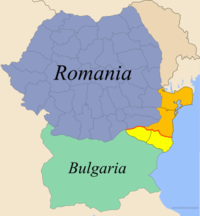- Treaty of Craiova
-
The Treaty of Craiova (Bulgarian: Крайовска спогодба; Romanian: Tratatul de la Craiova) was signed on 7 September 1940 between the Kingdom of Bulgaria and the Kingdom of Romania. Under the terms of this treaty, Romania returned the southern part of Dobruja (the Cadrilater or "Quadrilateral" in Romanian) to Bulgaria and agreed to participate in organizing a population exchange. The treaty was approved by Germany, the United Kingdom,[1] the Soviet Union, Italy, USA,[2] and France.[citation needed]
Terms of the Treaty provide for the mandatory resettlement of Romanian citizens of Bulgarian ethnicity living in Northern Dobruja to Bulgaria, and the resettlement of ethnic Romanians living in Southern Dobruja to Romania. 110,000 Romanians (80,000 of them from South Dobruja) were forced to leave their homes in Southern Dobruja and other parts of Bulgaria. Most of these Romanians were colonists who had settled there after the Second Balkan War in 1913, when the territory was annexed by Romania (see Treaty of Bucharest (1913)). 65,000 Bulgarians left their homes in Northern Dobrudja and resettled in Bulgaria.
See also
References
- ^ The New York Times, July 26, 1940, "Britain recognizes the "fundamental justice" of Bulgaria's claim against Rumania for return of the wheat-growing section of Southern Dobruja"
- ^ Кузманова, Антонина. От Ньой до Крайова. Въпросът за Южна Добруджа в международните отношения /1919-1940/, София 1989, с. 287-288.
Categories:- Dobruja
- Romania in World War II
- 1940 in Bulgaria
- 1940 in Romania
- Treaties concluded in 1940
- Treaties of the Kingdom of Romania
- Bulgaria–Romania border
- Treaties of the Kingdom of Bulgaria
- World War II stubs
Wikimedia Foundation. 2010.

